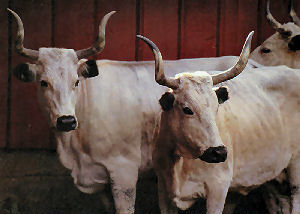The White Park Cattle are a longhorn breed.

British White Cattle are naturally polled and resemble the White Park in color only.
The White Park is a horned cattle breed which is white with colored points. These points include the ears, nose, rims of eyes, teats and feet but excludes the tail switch. The upper portion of the tongue should be black while underneath is most often pink. The intensity of these markings varies from herd to herd.
The White Park Cows are known to be quite tall and very angular (resembling Texas Longhorns in body shape). They have been billed as cows that are extremely active and alert cattle with large flight zones that require careful handling.
How long has it been since you searched for White Park Cattle on eBay? and on Amazon? I just did and found it pretty hard to understand such a big difference in the results, WOW.
White cattle with colored points are first mentioned in old Irish sagas dating back almost 2,000 years. They are later found again in Welsh law which was formulated at Dynevwr Castle in Deheubarth by a series of rulers from 856 to 1197 AD. The Dynevor herd dates to this time. The Chartley and Chillingham herds of England and the Cadzow herd in Scotland date to the mid-thirteenth century when herds in England and Scotland were enclosed in hunting chases. Writers of the time differed as to the origin of the herds. Some contended they were brought to Britain while others, including the famed authority Rev. John Storer, believed they were the direct descendants of the Wild White Bull that roamed the forests which once covered the British Isles.
In the early 1800’s, at the time of Storer’s writing, there were more than a dozen pure White Park herds though most were exterminated by the turn of the century. Of the six ancient herds remaining, the best known is the Chillingham herd. The registration program for While Park cattle was started in the early 1900s, but lapsed with the outbreak of World War II in the 1940’s. At that stage only the Dynevor, Woburn, Whipsnade and Cadzow herds survived as domesticated herds, and the Chillingham and Vaynol as semi-feral herds. When the Rare Breeds Survival Trust was formed in Britain in 1973 these remaining herds were given the communal name “White Park”.
In the late 1930s one or two pairs of White Park cattle were imported to Canada. Their offspring eventually made its way to the Bronx Zoo. A tale persists that these cattle were taken out of Britain to America to save a national treasure. Sources vary on their views of these events with some stating it was purely a business transaction.
Shortly after receiving the White Park cattle, the Bronx Zoo determined they did not have facilities to house the wild cattle for the long term. The zoo contacted the King Ranch and a deal was made which allowed four of the animals to be moved to Texas where they remained for nearly 40 years. When the White Park herd was to be sold it was purchased by Mr. and Mrs. John Moeckly of Polk City, Iowa.
In the 1970’s, White Park cattle were imported to both Canada and the US and semen from Dynevr bulls has been imported to both countries also.
In 1988 a small portion of the Moeckly herd was sold to the Seed Saver’s Exchange in Decorah, Iowa.
Shortly hereafter all but a few old cows were sold to the B-Bar ranch in Big Timber, Montana, along with the White Park registry.
The last remnant of the herd, made up of the aged females, was sold to Mark Fields of Clark, Missouri.
In 1995 there were five herds across North America. Currently the breed is found in Britain, the United States, Germany, Denmark, Australia and Canada.
The White Park cattle in the United States have been DNA typed for purity and to determine the best breeding plan possible to save its genetic base. An on-going breeding program has been put into place to help ensure the breed’s survival.
The story goes that the White Park is genetically far distant from all British breeds and has been established by blood typing. The breeds that appear to be most closely related to the White Park are the Highland and Galloway of Scotland.
The White Park is a medium-size animal with mature bulls in working condition weighing approximately 2100 pounds and cows 1400 pounds. Their value in the beef industry lies in the high quality of their meat and in their great genetic distance from other breeds which will increase the heterosis effects in crossbreeding systems.
